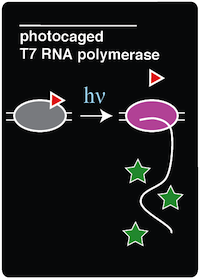Team:Austin Texas/photocage
From 2014.igem.org
Nathanshin (Talk | contribs) |
Nathanshin (Talk | contribs) |
||
| Line 113: | Line 113: | ||
*(+)IPTG, (+) ONBY | *(+)IPTG, (+) ONBY | ||
| - | Each of the conditions were in sterile test tubes and contained 1 mL of media and appropriate antibiotics. These cultures were allowed to grow for 2 hours. After 2 hours of growth, IPTG was added to all (+)IPTG condition tubes. The test tubes were allowed to grow another 2-4 hours, or until the OD600 reached 0.3. At this point, five 100 microliter samples of each of the strains were transferred into a 96-well plate. | + | Each of the conditions were in sterile test tubes and contained 1 mL of media and appropriate antibiotics. These cultures were allowed to grow for 2 hours. After 2 hours of growth, IPTG was added to all (+)IPTG condition tubes. The test tubes were allowed to grow another 2-4 hours, or until the OD600 reached 0.3. At this point, five 100 microliter samples of each of the strains were transferred into a 96-well plate. Each of the five samples represent a time interval of irradiation. |
| + | |||
| + | Next, the 96-well plate was covered in foil such that only the first column (which only contained samples that are to be irradiated for 30 minutes) was exposed. The handheld UV light was held 5cm over the 96 well plate and the first column was exposed to the 365 nm light for 15 minutes. After 15 minutes of exposure, the foil was removed to reveal the second column of cultures. Then, after another 10 minutes of exposure, the foil was removed to exposed the third column. After another 4 minutes, the fourth column was exposed. Finally, after the final 1 minute of exposure, the plate was re-covered with foil. | ||
| + | |||
| + | |||
After irradiation with light, these cells were allowed to grow overnight before taking fluorescent measurements. This additional growth was necessary to allow the "decaged" T7 RNAP to polymerize mRNA transcripts of the GFP coding sequence. | After irradiation with light, these cells were allowed to grow overnight before taking fluorescent measurements. This additional growth was necessary to allow the "decaged" T7 RNAP to polymerize mRNA transcripts of the GFP coding sequence. | ||
Revision as of 03:22, 17 October 2014
| |||||||||||||||||||||||||||||
 "
"




